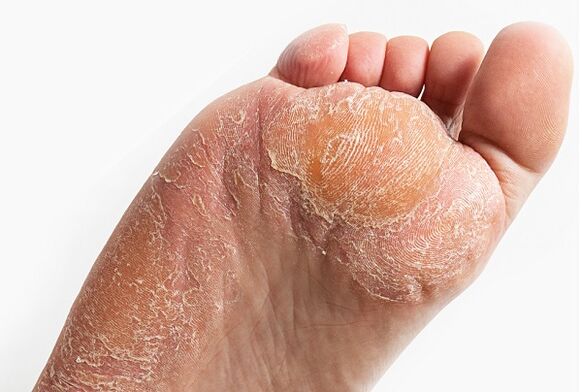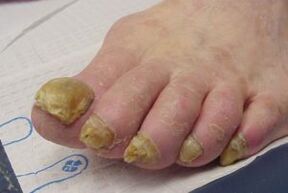Toenail fungus, the symptoms of which will be discussed below, most often occurs due to neglect of personal hygiene rules. Symptoms of nail fungus occur suddenly in most patients because the infection occurs almost imperceptibly and instantly. Since the treatment of this disease lasts for a long period of time, it is better for those who notice signs of the disease on the toenails, to consult a doctor immediately.

Factors that contribute to the development of the disease
Damage can be caused by yeast, mold or skin fungi. In the first case it is impossible to immediately diagnose the disease. Symptoms of the disease appear 5-6 months after infection. Nail exfoliation develops, slight irritation of the skin around. Sometimes the patient suffers from severe itching.
If the disease has developed due to a skin fungus, then three scenarios are possible:

- Infected feet, nails and skin of feet. The fungus can spread not only on the skin of the lower extremities, but also on the nails of the hands.
- Other types of mycelium affect only the little finger or toe. Sometimes such fungi move to the folds between the fingers. Then the skin is grazed either 1-2 folds, or simultaneously.
- Another type of disease - the fungus is confined to the little finger or thumb of the lower limb, "catching" the nail plate, but does not spread further.
- The last type of infection is mold. This type of mycelium is usually found in people with severe immune disorders such as HIV.
Infection occurs in all cases for the following reasons:
- The protective properties of the patient's body have dropped to a critical level.
- The nail was mechanically damaged.
- The man was wearing very tight shoes. Blood circulation in the legs was disrupted, leading to the development of infection.
- Some people have anatomical pathology of the foot, which contributes to the development of fungi.
- Most often, patients who are diagnosed with obesity experience the disease. The disease causes excessive sweating. This creates favorable conditions for the development of mycelium.
- Fungi develop in patients with diabetes.
To prevent the disease, you should use only your clothes, shoes, personal hygiene items. It is recommended to decontaminate carpets and shoes and clean them in a timely manner.
General signs of the disease

The first signs of toenail fungus in most people start in the form of small whitish dots or streaks on the toenails. Most people do not pay attention to this because nothing hurts them, there is no discomfort. If you do not start treatment for mycosis in time, then you can start the disease. There will be mycelium irritation on all the plates of the nail, the skin will start to pus around the damaged nails. In severe cases, the disease spreads to deep tissue structures. This threatens the development of gangrene and amputation of the leg or even the entire leg.
In the second stage of the disease with mycosis disappears the natural radiance of the nail plates. The nails change color. They are yellow with brown or white stripes. The upper and lateral surfaces of the nail are often deformed. Such changes are clearly visible to the naked eye.
In the last stage of the disease the nail plates become very brittle, the inflammatory process begins on the cuticle. A person can completely lose a nail. But the fungus does not stop there. They continue to spread on all the nail plates and then move to the skin of the foot, i. e. catch the feet.
The patient himself can diagnose the disease in the second and third stages, as the nails turn yellow or brown (sometimes black). The nail climbs out of bed, gaining fragility, falling apart quickly.
Symptoms of the disease at an early stage
If a person has developed toenail fungus, the symptoms of the disease are virtually non-existent at first. But then, 2-3 months after the fungus penetrates the skin and fixes it on the nails, you may notice the appearance of such signs of the disease:
- With a damaged plate on the surface of the skin, a slight redness develops at first.
- Then the person feels a burning sensation in this area.
- Develops severe itching, inflammation begins.
- Subsequently, areas of increased humidity develop in these areas.
- There is a thickening of the nail and its keratinization.
As soon as a person notices these signs of nail fungus, he should be examined and then start treatment.
Depending on the type of fungal infection, in the later stages of mycosis development, the diseased nail plate is painted in different colors. In the first stage of the disease, the affected area may become white or green. Spots on it are located along the surface or look like round dots. At the same time, the thickness of the plate does not change in most patients and in many cases the nail retains its natural shine. The itching is very strong in all cases, it is impossible to get rid of it immediately. If the patient notices signs of mycosis in time, then you can get rid of the burning and itching by taking medications such as miconazole, clotrimazole and similar drugs. But you should not treat it independently, it is better to do it under the supervision of a doctor. In case of any mistake or non-compliance with the doctor's recommendations, the mycelium will instantly spread to healthy areas, complicating treatment.
Further development of the disease
Without treating the fungus on the toenails, the nails can take on a natural color and the surface color of the damaged area will be yellow. The nails are disintegrating. They may begin to break down. However, the patient develops unbearable itching on the skin around the damaged area. Begins to break down the substance in the nail plates. The burning intensifies. Some patients may develop dysbacteriosis, they feel ill, complain of weakness throughout the body. May develop drowsiness.

First the mycelium completely changes the color of the surface of the plates, then their thinning begins. The diseased nail is then rejected and the infection penetrates the skin structures. The itching gets worse.
In the last stage of the disease, the surface of the diseased nail plates becomes similar to scales. Depending on the species of fungus that struck the person, the nails begin to thicken, breaking them down. They disintegrate quickly. Symptoms of the disease include the following:
- The edges of the plates become very brittle. Sometimes it causes the patient pain.
- The shape of the plates is very distorted and a scaly surface may develop.
- The color of the damaged area turns black from yellow.
- Begin inserting parts of the plates into the skin.
- A whitish or yellowish coating appears under the nails. This is caused by their removal from the bed.
- The itching is very strong, almost unbearable. Burning of the skin around the damaged areas continues to increase.
If these symptoms appear and treatment is started in time, then it will continue for a long time. Illness can infect you in 4-5 seconds and the disease is very difficult to cure. This usually takes 3 to 6 months. It is not recommended to skip the course of treatment due to possible complications that may result from surgery. Therefore, you need to listen to yourself carefully. If the initial symptoms appear and treatment is started immediately, then there is a chance to finish the therapy faster, while saving the nails.































